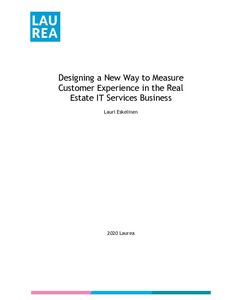Designing a New Way to Measure Customer Experience in the Real Estate IT Services Business
Eskelinen, Lauri (2020)
Eskelinen, Lauri
2020
All rights reserved. This publication is copyrighted. You may download, display and print it for Your own personal use. Commercial use is prohibited.
Julkaisun pysyvä osoite on
https://urn.fi/URN:NBN:fi:amk-2020121628594
https://urn.fi/URN:NBN:fi:amk-2020121628594
Tiivistelmä
Customer experience has a significant effect to companies’ financial results. It relates to many different aspects of companies’ operations, and if handled poorly, can have significant negative effects. Many companies think that they provide quality service, but their customers might have a different opinion. Therefore, the actual service level is not clear. For the companies to be able to discover the actual service level delivered, constant and regular measurement of customer experience is required. The objective of this thesis is to discover answers to the question “How to utilize co-creation and facilitation methods in designing a new way to measure Customer Experience and manage results systematically”. The development goal of this thesis is to create a new way to measure customer experience at the case company, and how service design can be used to create process concepts to manage results in a systematic way.
Customer-dominant logic is the theoretical approach adopted in this study. The knowledge base of customer experience (CX) and customer experience management (CEM) was used to develop the theoretical framework, so that the context of the study could be understood. Synergies between service design, customer experience and customer experience management were examined in this framework. Development of service business and service design are discussed in order to understand how the new way to measure customer experience should be developed. Research questions, such as “What issues should be considered when starting to measure customer experience?”, and the suitability of collaborative service design methods and tools in a traditional business context are reflected.
The research approach was a qualitative case study in the field of Real Estate IT services and the case is a real-life research-oriented development project. Service design process model Double Diamond is followed in the empirical part, and several service design methods and tools are used. Altogether eight contextual staff interviews were conducted to gather insights of the needs, risks and benefits concerning the follow-up processes — functionalities, non-functionalities, gains, and current challenges. Deductive content analysis was used to explore the interview data and the insights were mapped during the second process phase into Affinity Diagrams. Four follow-up process concept drafts (MVP’s) for the selected touchpoints’ survey responses were formed in two internal staff workshops. These are the main empirical outcomes. Other methods used were follow-up process System map, Empathy maps, Service blueprints, Stakeholder maps, Customer journey maps and prototyping.
This study developed a customer-centric framework with which organizations can get authentic customer data continuously, and to discover opportunities to develop business in interactions where customer expectations and experiences do not meet. This framework can act as a valuable tool in developing measurement of customer experience in different organizations in a customer-centric way. The main conclusion is that it should always start from the customer, from their journey, and what interactions are the most important to them. Further research could investigate the possibilities to utilize the framework also in developing measurement of employee experience and candidate experience.
Customer-dominant logic is the theoretical approach adopted in this study. The knowledge base of customer experience (CX) and customer experience management (CEM) was used to develop the theoretical framework, so that the context of the study could be understood. Synergies between service design, customer experience and customer experience management were examined in this framework. Development of service business and service design are discussed in order to understand how the new way to measure customer experience should be developed. Research questions, such as “What issues should be considered when starting to measure customer experience?”, and the suitability of collaborative service design methods and tools in a traditional business context are reflected.
The research approach was a qualitative case study in the field of Real Estate IT services and the case is a real-life research-oriented development project. Service design process model Double Diamond is followed in the empirical part, and several service design methods and tools are used. Altogether eight contextual staff interviews were conducted to gather insights of the needs, risks and benefits concerning the follow-up processes — functionalities, non-functionalities, gains, and current challenges. Deductive content analysis was used to explore the interview data and the insights were mapped during the second process phase into Affinity Diagrams. Four follow-up process concept drafts (MVP’s) for the selected touchpoints’ survey responses were formed in two internal staff workshops. These are the main empirical outcomes. Other methods used were follow-up process System map, Empathy maps, Service blueprints, Stakeholder maps, Customer journey maps and prototyping.
This study developed a customer-centric framework with which organizations can get authentic customer data continuously, and to discover opportunities to develop business in interactions where customer expectations and experiences do not meet. This framework can act as a valuable tool in developing measurement of customer experience in different organizations in a customer-centric way. The main conclusion is that it should always start from the customer, from their journey, and what interactions are the most important to them. Further research could investigate the possibilities to utilize the framework also in developing measurement of employee experience and candidate experience.
